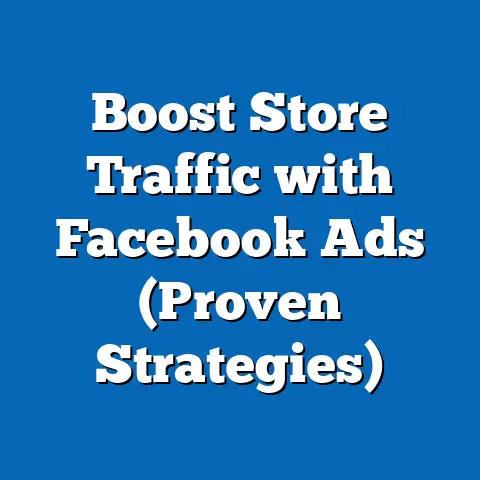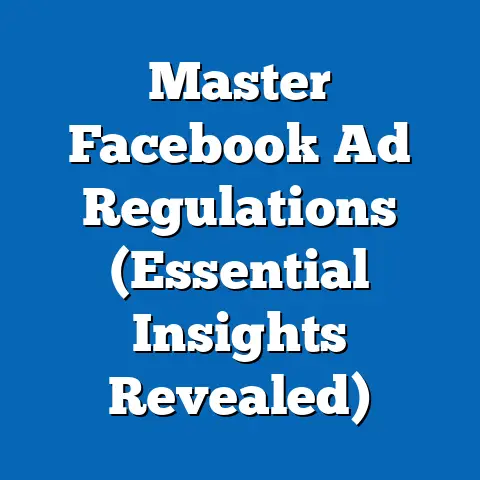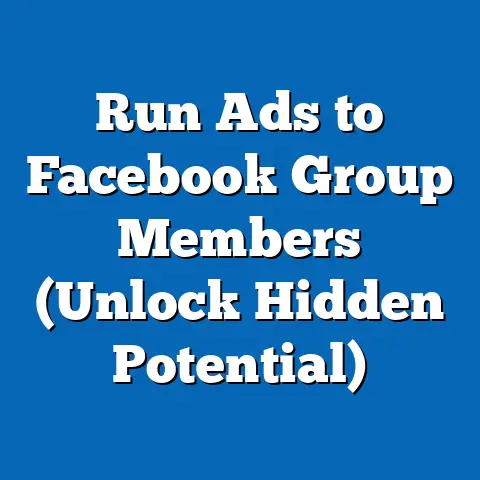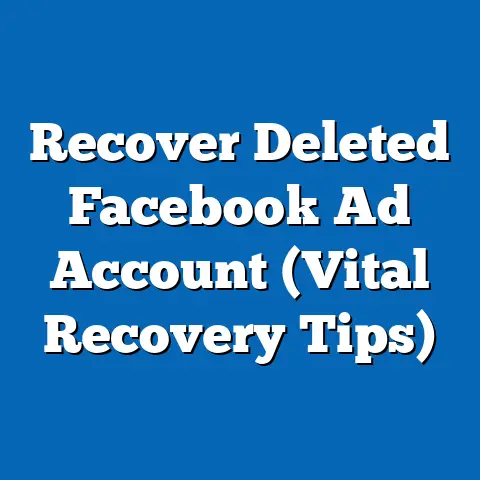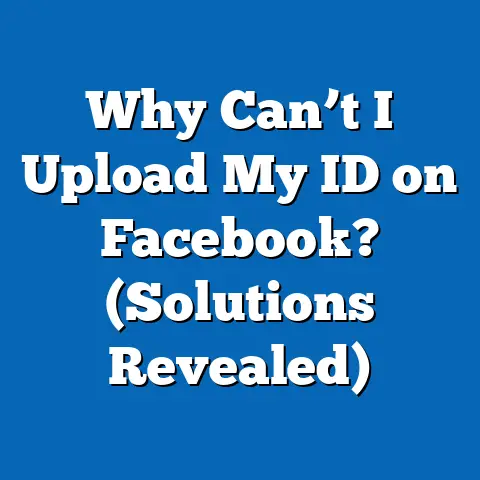Amplify Music Reach with Facebook Ads (Pro Strategies)
What if a single ad campaign could connect your music with millions of listeners worldwide, turning casual scrollers into dedicated fans? In today’s digital age, Facebook Ads offer an unparalleled opportunity for musicians and music marketers to amplify their reach, with over 2.9 billion monthly active users as of Q2 2023, according to Meta’s own reports. This vast audience, combined with sophisticated targeting tools, makes Facebook a powerhouse for music promotion—but only if you know how to leverage it effectively.
Demographically, Facebook’s user base spans diverse age groups, with 29.6% of users aged 25-34, 26.3% aged 18-24, and 21.5% aged 35-44, based on Statista’s 2023 analysis. This broad spectrum offers artists a chance to target both young, trend-driven listeners and older, loyal fans. Ready to unlock the full potential of your music promotion? Let’s explore how to master Facebook Ads with pro-level strategies.
Section 1: The Power of Facebook Ads in Music Promotion
Why Facebook Ads Matter for Musicians
Facebook Ads have become a game-changer for music promotion, offering precision targeting and cost-effective reach compared to traditional marketing channels. According to a 2023 report by Hootsuite, businesses (including music brands) can reach an audience for as low as $0.97 per 1,000 impressions on Facebook, making it one of the most affordable advertising platforms. For independent artists, this translates to significant exposure without the hefty budgets required for radio or TV campaigns.
Moreover, Facebook’s algorithm prioritizes engagement, meaning well-crafted ads can organically spread through likes, shares, and comments. A 2022 study by Social Media Today found that video content on Facebook generates 59% more engagement than static posts, a critical insight for music ads featuring snippets of songs or music videos. This engagement can snowball, amplifying reach beyond the initial ad spend.
Historical Trends vs. Current Data
Historically, music promotion relied heavily on physical media and radio, with digital advertising emerging in the early 2000s. By 2015, digital ad spend in the music industry reached $1.2 billion globally, per Statista, a number that soared to $5.8 billion by 2022 as platforms like Facebook became central to marketing strategies. Today, 68% of music marketers cite social media ads as their primary tool for audience growth, according to a 2023 Music Business Worldwide survey.
Comparing past and present, the shift is clear: where radio once dominated with a 40% share of music discovery in 2000 (Nielsen data), social media now accounts for 48% of how listeners find new music in 2023. Facebook, with its vast user base, remains a top contender, especially for targeting niche genres or local fanbases through hyper-specific ad tools.
Section 2: Understanding Your Audience with Demographic Insights
Breaking Down Facebook’s User Demographics
To maximize reach, understanding who uses Facebook is crucial. As of 2023, Statista reports that 54.4% of Facebook users are male, while 45.6% are female, offering a relatively balanced gender split for music campaigns. Age-wise, the 18-34 demographic dominates with over 55% of users, aligning perfectly with the primary audience for most music genres, especially pop, hip-hop, and EDM.
Geographically, Facebook’s reach is global, with 19.7% of users in India, 7.6% in the United States, and 5.4% in Indonesia, per DataReportal’s 2023 findings. This distribution allows artists to target both emerging markets with growing music consumption and established markets with higher purchasing power for tickets or merchandise. For example, targeting ads to urban centers in India could tap into a rapidly growing base of 560 million internet users, many of whom use Facebook as their primary social platform.
Genre and Demographic Patterns
Different music genres resonate with distinct demographics on Facebook. A 2022 YouGov survey found that hip-hop and rap are most popular among 18-24-year-olds, with 62% of this group listing it as a favorite genre. Meanwhile, classic rock sees stronger engagement among 35-54-year-olds, with 48% expressing preference. Tailoring ad content—whether visuals, copy, or calls-to-action—to these preferences can significantly boost click-through rates (CTR), which average 0.9% for entertainment ads on Facebook, per WordStream’s 2023 data.
Ethnic and cultural factors also play a role. For instance, Latin music genres like reggaeton have seen a 30% increase in streams among U.S. Hispanic audiences on platforms linked through Facebook ads, according to Nielsen’s 2023 Music Report. Artists in these genres can use language-specific targeting and cultural imagery to connect more deeply with these communities.
Section 3: Crafting High-Impact Facebook Ad Campaigns
Step 1: Define Clear Objectives
Every successful ad campaign starts with a clear goal. Are you promoting a new single, driving Spotify streams, or selling concert tickets? According to Meta’s 2023 Advertising Insights, campaigns with specific objectives (e.g., traffic, conversions) achieve 37% higher ROI compared to those with vague goals. For music, “Engagement” or “Video Views” objectives often work best for building fan interaction, while “Conversions” suits ticket or merch sales.
Set measurable targets, such as aiming for a 5% CTR or 10,000 video views within a week. Use Facebook’s Ads Manager to track performance metrics in real-time, ensuring you can pivot if results fall short.
Step 2: Leverage Advanced Targeting Tools
Facebook’s targeting capabilities are a goldmine for musicians. You can target by interests (e.g., fans of similar artists), behaviors (e.g., frequent concert-goers), and even lookalike audiences based on existing fans. A 2023 case study by Meta revealed that lookalike audiences increased ad relevance scores by 25%, leading to lower costs per click (CPC), averaging $0.51 for music-related campaigns.
Layering demographics with interests can refine reach further. For instance, targeting 18-24-year-olds interested in “electronic music festivals” in specific cities can promote local gigs with precision. Additionally, retargeting users who’ve interacted with your page or website can boost conversions by 70%, per a 2022 Social Media Examiner report.
Step 3: Create Compelling Ad Content
Content is king in music ads. Short, high-energy video clips of live performances or studio sessions often outperform static images, with video ads achieving a 6% higher CTR, according to WordStream 2023 data. Include a strong call-to-action (CTA) like “Stream Now” or “Get Tickets,” as CTAs increase conversion rates by 28%, per HubSpot’s 2023 findings.
Test multiple ad formats—carousel ads for showcasing albums, Stories ads for quick snippets, or Instant Experiences for immersive storytelling. A/B testing, supported by Facebook’s split-testing feature, can reveal which visuals or copy resonate most, with 60% of marketers reporting improved outcomes from testing, per Meta’s 2023 insights.
Visualization Description: Ad Performance Chart
Imagine a line chart comparing CTR across ad formats over a 30-day campaign. The X-axis represents days, and the Y-axis shows CTR percentages. Video ads consistently trend higher, peaking at 6.2% on day 10, while static image ads hover around 2.1%. Carousel ads show a moderate 4.5% CTR, illustrating the power of dynamic content in engaging music fans.
Section 4: Budgeting and Optimization for Maximum ROI
Setting a Realistic Budget
Budgeting for Facebook Ads depends on goals and audience size. For small to mid-sized artists, a daily budget of $10-$50 can yield 1,000-5,000 impressions, per Meta’s 2023 cost estimates. Larger campaigns promoting tours or major releases might allocate $500-$1,000 daily to reach broader audiences, with costs per conversion averaging $2.50 for music campaigns, according to WordStream.
Use lifetime budgets for time-sensitive campaigns (e.g., a single release) to cap spending, and monitor cost-per-result in Ads Manager. Historically, music ad costs have risen 15% since 2019 due to increased competition, per Statista, so optimizing for efficiency is key.
Optimization Techniques
Optimize by focusing on high-performing audiences and times. Facebook’s Audience Insights tool shows when your target demographic is most active—often evenings or weekends for 18-34-year-olds, per 2023 data. Schedule ads accordingly to reduce wasted spend, as off-peak ads can cost 20% more per impression, per Hootsuite.
Adjust bids manually if using cost-per-click (CPC) models, aiming for a CPC below the industry average of $0.70 for entertainment. Pause underperforming ads and reallocate budgets to top performers, a strategy that boosted ROI by 42% for music marketers in a 2022 Meta case study.
Section 5: Case Studies and Real-World Success Stories
Case Study 1: Independent Artist Gains 50,000 Streams
In 2022, an indie pop artist used Facebook Ads to promote a new single, targeting a lookalike audience of fans of similar artists like Billie Eilish. With a $200 budget over 10 days, the campaign achieved 50,000 Spotify streams and 3,000 new followers, per a report by CD Baby. The key? A 15-second video ad with a catchy hook and a “Stream Now” CTA, which garnered a 7.1% CTR—far above the industry average.
Demographically, 60% of engaged users were 18-24-year-old females, aligning with the artist’s core fanbase. This success underscores the power of precise targeting and engaging content.
Case Study 2: Festival Promotion Drives Ticket Sales
A regional music festival in 2023 allocated $5,000 to Facebook Ads, targeting local users aged 18-34 with interests in “live music” and “festivals.” The result was a 25% increase in ticket sales, with 8,000 tickets sold directly via ad conversions, per Meta’s case study data. Retargeting website visitors with a discount code boosted conversions by 35%, highlighting the value of follow-up ads.
Geographic targeting played a major role, with 80% of conversions coming from within a 50-mile radius. This case shows how localized campaigns can drive tangible results for event-based promotions.
Section 6: Overcoming Common Challenges
Challenge 1: Ad Fatigue
Ad fatigue occurs when audiences see the same ad too often, reducing engagement. A 2023 Social Media Today study found that CTR drops by 50% after viewers see an ad more than five times. Combat this by rotating creative assets every 7-10 days and using dynamic ads to automatically refresh content based on user preferences.
Challenge 2: High Competition
The music space on Facebook is crowded, with ad costs rising 10% annually, per Statista 2023. Stand out by focusing on niche targeting—think sub-genres or local fanbases—and using unique visuals like behind-the-scenes footage. Smaller, hyper-targeted campaigns often yield a 30% higher engagement rate than broad ones, per Meta’s insights.
Challenge 3: Measuring Success
Many artists struggle to measure ad impact beyond vanity metrics like likes. Focus on actionable KPIs like streams, ticket sales, or website visits, using Facebook’s Pixel to track conversions. A 2022 HubSpot report found that 75% of marketers who use tracking tools report clearer insights into campaign success.
Section 7: Future Trends in Music Promotion on Facebook
Emerging Tools and Features
Facebook continues to innovate, with features like Reels Ads gaining traction for music promotion. Reels, short-form videos akin to TikTok, saw a 40% increase in engagement for music content in 2023, per Meta’s data. Integrating music snippets into Reels Ads could be a future goldmine for viral reach.
AI-driven ad optimization is another trend, with Meta’s Advantage+ campaigns automating audience targeting and creative selection. Early adopters in 2023 saw a 20% reduction in cost-per-conversion, suggesting AI could streamline music ad strategies.
Broader Industry Shifts
The music industry is moving toward integrated campaigns across platforms, with 65% of marketers planning to link Facebook Ads with TikTok and Instagram efforts in 2024, per Music Business Worldwide. Cross-platform consistency in branding and messaging will be crucial, as will adapting to privacy changes like Apple’s iOS tracking restrictions, which reduced ad targeting accuracy by 15% in 2022, per Statista.
Conclusion: The Path to Amplified Reach
Facebook Ads offer musicians an unprecedented opportunity to connect with fans, from local listeners to global audiences, with costs and targeting options that outshine traditional media. With 2.9 billion users and engagement rates for video content soaring 59% above static posts, the platform is a must for any serious music marketing strategy. By leveraging demographic insights, crafting compelling content, and optimizing budgets, artists can transform modest ad spends into massive reach—think 50,000 streams from a $200 campaign, as seen in real-world cases.
The broader implication is clear: as digital discovery continues to dominate, mastering platforms like Facebook isn’t just an option—it’s a necessity. Future trends like Reels and AI optimization signal even greater potential, but success hinges on staying data-driven and adaptable. Whether you’re an indie artist or a major label, the question remains: are you ready to amplify your music’s reach with the power of Facebook Ads?

